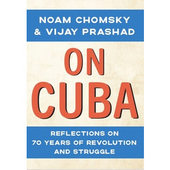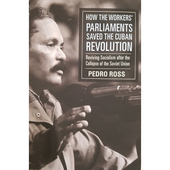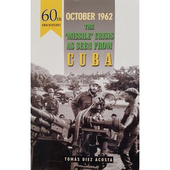Red Zone Cuba and the Battle Against Ebola in West Africa
By Enrique Ubieta Gomez
Pub. Pathfinder Press, 2020
“A powerful, unique and riveting read” about the Cuban medical brigades that have gone to work in the Red Zone, the area of highest contamination of the deadly Ebola.
£16.50 inc p&p
| Check Basket |
Review of The Red Zone
The word heroes is regularly used and abused in modern language, but never has it been more apt when describing Cuba’s volunteer doctors, nurses, technicians and public health specialists who responded to an international call for help in the fight against Ebola. Describing it as a “suicidal mission” 300 were selected out of the 12,000 who volunteered to go in 2014 to Guinea, Sierra Leone and Liberia. In a matter of weeks a Brigade of 256 were headed out after intensive training in Cuba.
The Red Zone is the area with the highest levels of contamination; patients presenting symptoms are isolated there until they recover or die. Brigade head in Guinea Dr Carlos Castro Baras tells how “We were all afraid at the beginning - afraid when we suited up, afraid when we entered the Red Zone, afraid when we touched anything, when we walked. We had all the symptoms of psychological terror.” With temperatures reaching 50 degrees the hermetically sealed ‘space suits’ were fatigue-inducing but vital as around 70% of those arriving at the treatment centre had Ebola and mortality/infection rates were very high.
Team spirit is always evident and Dr Rotceh Rios Molina says “we established a norm that was followed everywhere in Sierra Leone. There were no differences between doctors and nurses. Everyone had to perform IV insertions, wipe bottoms, and mop up vomit”. Youngest member, 25 year old Victor Lazzaro Guerra Viera was a paediatric nurse in Cuba. He describes how “I was called to see a child who needed an emergency IV in order to receive a blood transfusion… the family had no money to pay for the transfusion. So we pooled some of our own money, paid for the blood bag…I was told the boy had tested positive for Ebola but his life was saved thanks to what we had done at that moment.”
Dr. Felix Baez Sarria contracted Ebola himself and was dangerously ill. Transferred to Geneva it was a harrowing time for the whole of Cuba who felt his family’s pain. Dr Jorge Perez sat by his isolation bed for days until he regained consciousness. During those first few hours Felix shocked him when he said “Prof, I feel lousy, but I’m going to recover. And I am going back to Sierra Leone”. Jorge says “I was really moved because here was a man who was dying and suddenly he says that”. And he did return to finish his mission.
At times the narrative jumps between places, people and points of interest but collectively it is a powerfully unique and riveting read. The passion, commitment and dedication of not just the medical volunteers, but the whole Cuban nation who support them is inspirational. It is also a compelling refutation of the US government’s slanderous slurs against the internationalism and humanitarian medical cooperation Cuba gives to the world, not least the poorest. The Cubans may resist being called heroes, perhaps because they genuinely are.
c.Bob Oram for CubaSi Spring 2020 magazine












